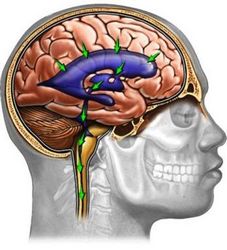Intraventricular hemorrhage in infants
Description intraventricular hemorrhage in infants
Intraventricular hemorrhage (FFA) there, when small blood vessels burst and bleed into the ventricles of the brain of the child. Želudočki – cavities in the brain, filled with cerebrospinal fluid (CSF). In most cases, the bleeding gradually stops and the blood vessels heal. In the event of IVH, corrective surgery can not be performed. If brain tissue is damaged, the child may have problems with the development in the future. IVH is the most common problem among premature infants.

Causes of intraventricular hemorrhage in infants
Often it is not clear, Why are there hemorrhages. Changes in blood pressure in the brain of a child can lead to rupture of blood vessels. This can occur during the first 48 hours after birth.
Risk factors for intraventricular hemorrhage in infants
Factors, which increase the risk of hemorrhage in the child:
- Prematurity;
- Low birth weight;
- Lack of oxygen;
- Direct trauma to the head of the child during birth (eg, pressure, due to the femur, forceps or vacuum extraction);
- Complications breathing at birth;
- Infection, which leads to blood clotting.
The symptoms of intraventricular hemorrhage in the child
In many cases, there are no visible signs of hemorrhage. If your child has any of the symptoms, it is not necessarily associated with IVH. These symptoms may be caused by other diseases. The hospital staff will examine your child, to visible, whether it has:
- Swelling of fontanelles at the top of the head (soft spots between skull bones);
- Apnea (respiratory arrest);
- Seizures;
- Muscle spasms;
- Pale or blue skin color;
- Weak sucking reflex.
Diagnosis of intraventricular hemorrhage in the child
The doctor will examine your child. He will look for signs of brain injury. There may be used the following tests:
- Ultrasonography – test, which uses sound waves to study the baby's head and find rupture of blood vessels and bleeding;
- Other Tests (eg, blood tests to check for anemia, metabolic acidosis, infection).
Treatment for intraventricular hemorrhage
Talk with your doctor about the method of treatment of the child. Treatment options include the following:
- Monitoring the condition of the child, To make sure, it remains stable;
- Treatment of diseases, resulting hemorrhage;
- Carrying out the various procedures, If the brain accumulates too much fluid, which can lead to brain damage. Procedures, that, perhaps, You have to make include:
- Poyasnichnaya puncture, fontanelle puncture, or surgery to drain fluid from the baby's brain;
- Stereotactically peritoneal shunt – the ventricles of the brain injected silicone drainage tube, is attached to an one-way valve. The tube then extends under the skin to the place in the abdominal cavity, where the absorption of excess liquor. Thus, created drainage, which is constantly present in the body. Replacement of the tube occurs as required.
Prevention of intraventricular hemorrhage in the child
It is impossible to prevent intraventricular hemorrhage, but there are some steps, that can be taken to reduce the risk:
- If there is a risk of having a premature baby, your doctor may prescribe medication, to reduce the likelihood of hemorrhage. It can be made steroid injections to reduce the risk of IVH;
- If you are pregnant, make sure, that you have passed all the prescribed prenatal tests.
